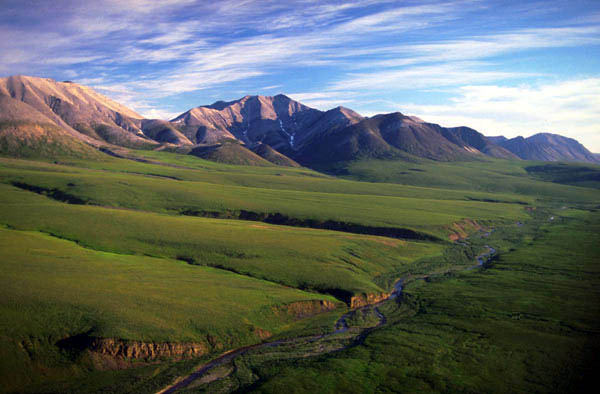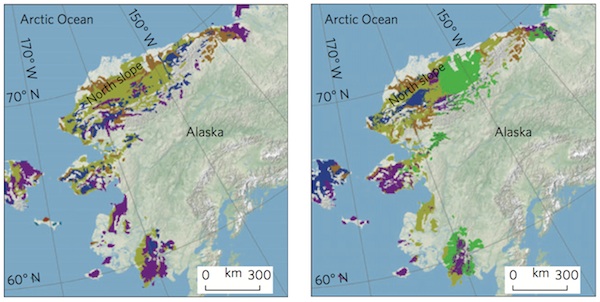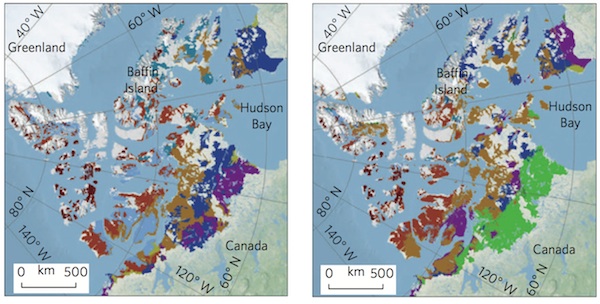The Greening of the Arctic is Underway
As the climate changes, trees and shrubs are poised to take over tundra and alter the Arctic’s ecosystems
![]()

As the Arctic warms, more of it will be covered by shrubs (like the Arctic National Wildlife Refuge, above) and even by forest. Image via ANWR
You probably think of the Arctic as a cold, frozen tundra—home to lichen, polar bears and scattered herds of reindeer. In many places, this view would be accurate, but in a few relatively southern areas in Canada, Alaska and Russia, warming temperatures over the past few decades have allowed new types of plants, such as shrubs, to take root.
And by 2050—if current warming trends continue—we’ll see a dramatically different ecosystem across the Arctic, starting with something that’s largely unknown in the area currently: trees. According to research published today in Nature Climate Change, tree cover in the Arctic could increase by more than 50 percent over the next few decades.
The research team, which included scientists from a number of universities and was led by Richard Pearson of the American Museum of Natural History, made the calculation based off of current projections of how the Arctic’s climate will change by 2050. So far, temperatures in the region have risen about twice as fast as those for the planet as a whole.
They created a model that predicts which class of plants (various grasses, mosses, shrubs or trees) will grow given a particular temperature and precipitation range expected for the future; for each spot on a map of the Arctic, they fed in the 2050 projections. Doing this kind of vegetative modeling for the Arctic, they say, is relatively straightforward compared to doing it for somewhere like the tropics, because there are hard limits on the temperature and growing season length that given plant types can tolerate.
They found that tree cover will expand drastically, covering up to 52 percent more land area than currently, rising far north of the current tree line in Alaska and Canada. This new tree cover will mostly come at the expense of areas currently covered by shrubs, but shrubs will take over places now dominated by tundra plants (lichens and mosses), and some areas presently under ice will convert into tundra.
In effect, the area’s warming climate and lengthening growing season will shift all current vegetation zones to more northerly and colder regions. Already, these vegetation zones have shifted an average of five degrees of latitude over the past 30 years–in other words, the vegetation in one spot resembles how a location five degrees south looked 30 years ago.
But by 2050, this shift will be even more dramatic—perhaps equaling 20 degrees of latitude—and a projected 48 to 69 percent of the Arctic’s vegetated areas will switch to a different class of plants. Some rare plant species could be at risk of extinction if they’re not able to migrate as quickly as the vegetation zones move.

Presently (left), vegetated areas of Alaska are mostly covered by small shrubs and tundra mosses (represented by the pea green color). By 2050 (right), much of this area will be dominated forests (bright green). Image via Nature Climate Change/Pearson et. al.

In Canada, areas currently covered by tundra shrubs (purple at left) will be taken over by forest (bright green at right). Image via Nature Climate Change/Pearson et. al.
Because plants are the base of any food chain, this conversion will have wide-ranging effects, both locally and elsewhere. “These impacts would extend far beyond the Arctic region,” Pearson said in a press statement. “For example, some species of birds seasonally migrate from lower latitudes and rely on finding particular polar habitats, such as open space for ground-nesting.” Their migrations patterns would presumably be altered by the growth of forests on what had been open tundra.
Most troubling, the conversion of white, snow-covered land to dark vegetation will further affect the warming of the planet. Because darker colors absorb more radiation than the white of ice and snow, shifting large masses of land to a darker color is projected to further accelerate warming, creating a positive feedback loop: more warming leads to a greener Arctic, which leads to more warming.
Given all the other problems that the area is rapidly encountering as the climate changes—melting glaciers, increasing oil exploration and hybridizing bear species—it’s clear that the Arctic will be one of the most environmentally fragile regions of the planet over the coming century.
/https://tf-cmsv2-smithsonianmag-media.s3.amazonaws.com/accounts/headshot/joseph-stromberg-240.jpg)
/https://tf-cmsv2-smithsonianmag-media.s3.amazonaws.com/accounts/headshot/joseph-stromberg-240.jpg)